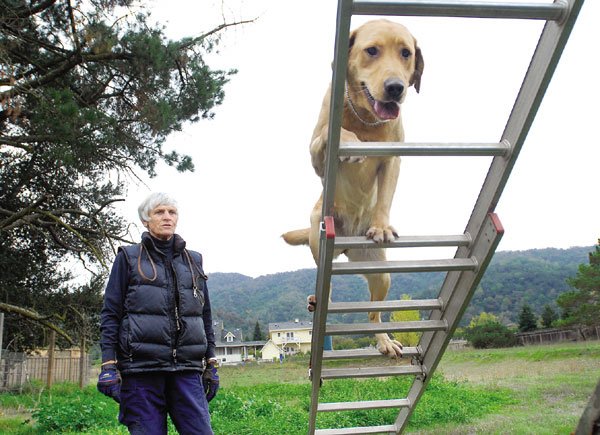A sleek black Labrador retriever called Ty sprints gallantly
around an expansive enclosure. He’s a dog on a mission,
scrupulously halting at various landmarks to briefly sniff before
rocketing away in another direction.
”
Good boy! You found me!
”
The voice belongs to Sharon Hanzelka, who, along with facilities
manager Kate Davern, specializes in transforming canine recruits
for the National Disaster Search Dog Foundation at Sundowners
Kennels. Their 14-year-old professional training establishment has
sent dogs by the dozens on to be working companions of firefighter
handlers.
A sleek black Labrador retriever called Ty sprints gallantly around an expansive enclosure.
He’s a dog on a mission, scrupulously halting at various landmarks to briefly sniff before rocketing away in another direction.
Ty scales an uneven heap of wooden pallets piled in a remote corner of the field, nimbly maneuvering uneven surfaces with careful paws. Perched on top of the debris is a big, blue barrel.
From inside, a woman’s words echo out in praise:
“Good boy! You found me!”
What appears to be a game of hike-and-seek simulates a potential life and death scenario.
The voice belongs to Sharon Hanzelka, who, along with facilities manager Kate Davern, specializes in transforming canine recruits for the National Disaster Search Dog Foundation at Sundowners Kennels at 8190 Honeycomb Lane off Hecker Pass Road in Gilroy. Their 14-year-old professional training establishment has sent dogs by the dozens – a majority of which were once homeless or scheduled to be euthanized – on to be working companions of firefighter handlers.
In November, one of Sundowners’ graduates, a 4-year-old black Labrador retriever and former shelter dog named Pearl, was named Dog of the Year by the American Society for the Prevention of Cruelty to Animals.
“People just give up,” Davern said. “These are dogs who want to be doing something. They’re sick and tired of being bored.”
With a little elbow grease, unconditional love and some serious patience, the SDF program at Sundowners offers unruly underdogs a second chance.
Such was the case with Pearl, who was surrendered to an animal shelter after her owner got sick of paying impound fees as the dog had a habit of jumping fences.
“If we could clone her, we would,” said Davern, looking back on the progress Pearl made after coming to Sundowners.
On Jan. 14, 2010, Pearl and handler Capt. Ron Horetski of the Los Angeles County Fire Department were deployed to Haiti as part of the Los Angeles County Task Force 2 team.
After a catastrophic magnitude 7.0 earthquake on Jan. 12, 2010 sent shattering seismic waves undulating beneath the Haitian town of Port-au-Prince, the pair scoured miles of ruins for victims lost in the sea of rubble that was once a city.
“It was overwhelming,” recalled Horetski, describing the jagged landscape of destroyed edifices. “If it wasn’t severely damaged, it was crushed.”
Horetski and Pearl, along with six other SDF canine disaster teams, eventually extrapolated 12 people from the mountains of crumbled concrete to safety.
The trip was Pearl’s first international deployment.
Horetski boasts about his four-legged partner like a doting father, taking care to let everyone know she’s the youngest and only female dog in the task force.
“It doesn’t make a difference,” he admitted. “I just like to brag.”
Horetski and Pearl received the award Nov. 11 at a special ceremony in New York City.
Upon learning of the ASPCA’s announcement, Davern said she got teary-eyed.
She said parenting the dogs through awkward-puppy adolescence and watching them go on to bigger and better things is like seeing kids off to college.
“If only they knew how (the dogs) were at the beginning,” chuckled Hanzelka.
The two brought out Rugby, a 1-year-old chocolate Labrador, to give a demonstration of what their dogs-in-training are capable of.
Or will be, after final kinks are worked out.
“You got a hold of him?” asked Davern.
“Not really – you need cleats with this dog!” yelped Hanzelka, digging her heels into the dirt.
On the other end of the leash, a spirited Rugby goofily pranced around with the happy-go-lucky energy of an excited child, visibly thrilled to be working.
Hanzelka, who has broken a tooth and separated her elbow in her years of training, said handling spirited canines in their physical prime is not for the weak of heart.
“We create these incredible monsters,” said Hanzelka. “They’re amazing. And worth every injury.”
She paused.
“Sometimes, not at the moment.”
Davern concurred, mentioning something about getting bitten in the back and tearing her rotator cuff.
Both agreed – their job is a bodily commitment.
Amidst conversation, loud barks emanated from the kennels where dogs and boarded occupants were kept. Each time, Davern and Hanzelka automatically turned their heads like concerned parents.
For 44-year-old Davern, who has lived in Gilroy for seven years, a love of dogs runs in the family. Her mother Pluis helped found the nonprofit SDF in 1996 with a retired schoolteacher from New Jersey named Wilma Melville. In what was initially a retirement hobby for Melville, she and her black Labrador retriever Murphy trained with Pluis and eventually attained Advanced Disaster Search Dog certification by the Federal Emergency Management Agency.
After Melville and Murphy were deployed in 1995 to the terrorist-bombed Alfred P. Murrah Federal Building in Oklahoma City, however, Melville abandoned retirement after she saw the need for more FEMA certified teams.
One year later, she and Pluis founded SDF with three golden retrievers that were scheduled to be euthanized.
Today, SDF is building a national training center in Wheeler Canyon near Santa Paula in Southern California. Currently there are 70 SDF-trained search teams located in California, Florida, New York, Oklahoma and Utah. Every single team can be shared regionally and nationally at no cost to fire departments.
“This has changed the face of disaster search in this country,” said Melville, now 77.
“We’ve influenced so many others to go to shelters and locate the dogs there.”
Davern and Hanzelka said they want to get the word out about what Sundowners can possibly do for “problem dogs.” The ones who seem impossible to manage or train may be able to funnel their spunkiness toward a higher purpose.
Davern defines prime candidates as “high-drive, insane, crazy dogs – the kind that have dug all the holes, chewed all the hoses and jumped every fence.”
Like Hunter, for example, the border collie who learned everything he knew from Sundowners in 2002.
Hunter was also in Haiti and found three girls four stories down in a pancake-collapsed structure, according to Davern.
Dogs who don’t fit the SDF profile, for that matter, frequently get a career change to another job they’re better suited for.
Even more promising for the pooches who are taken in, be it by Sundowners or any other branch of the SDF, is that they’ll never want for a home again.
Davern said rescued dogs are always taken care of, regardless of whether they become search dogs.
“The more people are aware we need wild, crazy dogs under 2, the better. We’ve got a potential job for them,” Davern said.
“We get them all the time,” added Hanzelka. “Dogs that look near death. And now they’re search dogs.”
Can you donate your dog to SDF?
Search dog profile:
– Labrador, golden retriever, border collie or other hunting or herding breed
– 9 to 18-months-old
– Excellent health – hip and elbow x-rays will be required
– Bold, energetic and athletic
– Well-socialized, not fearful of or aggressive to people or other – Not fearful of noises, sudden movements or unstable, hazardous footing
– Able to ignore extraneous noises
– For more information, go to GilroyDispatch.com.














